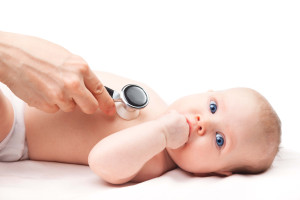
So many use descriptions of a mother's womb as the safest or most ideal environment or location, and yet there are actually conditions that can make the womb unhealthy for both mother and baby. The condition known as infant chorioamnionitis is a prime example of this.
It is a condition in which bacteria in the mother's body (usually from the vagina, rectum or anus) are able to move upward and infect the chorion and the amnion (these are the two different membranes that encase the baby), as well as the amniotic fluid. Clearly, living in a place that is full of infectious material is incredibly hazardous to the baby, and if left untreated can lead to serious infection to sepsis and death in both the mother and her baby (both before and after birth).
The Causes for Infant Chorioamnionitis
What allows bacteria to get so out of control? It is important to note that it isn't just any types bacteria that lead to infant chorioamnionitis. The most common include group B strep, E. coli, and anaerobic bacteria. These are infections that the mother can be easily tested for at any time, and absolutely should be tested for in order to reduce any risk factors.
Just consider that women under the age of 21, women experiencing first pregnancies, women who know that one of the membranes has ruptured, and women who have already had a lot of uterine and/or fetal monitoring will need to be screened for bacterial infection. Additionally, if a woman is in the midst of a long and stressful labor, the medical team should know to monitor for infections too.
Diagnosing the Condition
Diagnosis involves a physical exam as well as blood samples from the mother, and even samples of amniotic fluid or an ultrasound to gauge the health of the baby. A mother running a fever, experiencing uterine tenderness, having vaginal discharge or found to have foul smelling amniotic fluid, and if either the baby or the mother has tachycardia (overly fast heart rate), can easily mean that chorioamnionitis is possible.
While it might seem like it is an obvious condition, sometimes there are no signs at all. However, a physician is always supposed to conduct regular checks on the mother and baby's heart rates throughout the pregnancy. Any unhealthy or distinct changes in the heart rates will have to be investigated.
Quite often, a mother with a fever is the first sign of trouble, and this should trigger all of the follow up testing for the condition.
Treating Chorioamnionitis
If the tests indicate that an infection has taken hold, a physician tends to act very quickly. This is to remove the baby from the relatively toxic environment and all of the dangers it presents. So, a usual treatment is actually to quickly deliver the baby. This is especially true if there are signs that the baby has developed infections in the abdominal area, near the eyes, or in the bones and joints. If there is swelling or any sort of abscess near the brain, delivery of the baby will be done immediately.
Mothers are always treated with rigorous courses of antibiotics since they too can suffer a long list of health problems and dangers should infections go undiscovered or untreated. Infants born to mothers with this condition are also usually treated with antibiotics to limit any long term effects of the chorioamnionitis.
This condition is often viewed as a sort of birth injury since a baby is usually delivered early because of it, and this may place the baby at risk for other health issues. This all illustrates the importance of regular health checks throughout pregnancy and reporting any changes in health or wellbeing as soon as they develop.
Source:
ClevelandClinic.org. Chorioamnionitis. 2015.
http://my.clevelandclinic.org/health/diseases_conditions/hic_Am_I_Pregnant/hic_Premature_Labor/hic_Chorioamnionitis
 So many use descriptions of a mother's womb as the safest or most ideal environment or location, and yet there are actually conditions that can make the womb unhealthy for both mother and baby. The condition known as infant chorioamnionitis is a prime example of this.
It is a condition in which bacteria in the mother's body (usually from the vagina, rectum or anus) are able to move upward and infect the chorion and the amnion (these are the two different membranes that encase the baby), as well as the amniotic fluid. Clearly, living in a place that is full of infectious material is incredibly hazardous to the baby, and if left untreated can lead to serious infection to sepsis and death in both the mother and her baby (both before and after birth).
So many use descriptions of a mother's womb as the safest or most ideal environment or location, and yet there are actually conditions that can make the womb unhealthy for both mother and baby. The condition known as infant chorioamnionitis is a prime example of this.
It is a condition in which bacteria in the mother's body (usually from the vagina, rectum or anus) are able to move upward and infect the chorion and the amnion (these are the two different membranes that encase the baby), as well as the amniotic fluid. Clearly, living in a place that is full of infectious material is incredibly hazardous to the baby, and if left untreated can lead to serious infection to sepsis and death in both the mother and her baby (both before and after birth).
